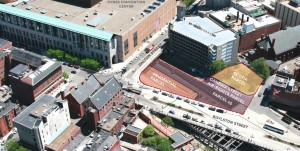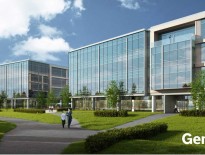
Despite complex permitting and financing hurdles, developers continue to pursue air rights projects on prime parcels in Boston. Boston-based Weiner Ventures has submitted updated plans for a 27-story condo tower atop a 2-story retail podium in Back Bay.
As real estate executives and tradespeople crowded into a tent for a groundbreaking ceremony last week, developers John Rosenthal and Kelly Saito shared a congratulatory hug to mark the long-awaited kickoff of the Fenway Center development.
The $240 million initial phase of 315 apartments is relatively modest in a city awash in new developments. But for Rosenthal, it was a momentous milestone in a 15-year campaign by his Newton-based firm, Meredith Management Corp., which was selected to redevelop the state-owned parcel near Fenway Park in 2002.
Fenway Center’s tortured history illustrates the unique challenges of air rights projects built over highways and rail lines in Boston. Questions linger about what’s needed to complete the trickier second phase, including a parking garage and two other buildings above the Massachusetts Turnpike.
“Investors are very spooked about building a deck over the highway and rail,” Rosenthal said. “You have to know how to build it and finance it, and that’s the next big challenge.”
The struggle to build air rights developments will continue to play out at a group of high-visibility sites in Boston as long as the commercial real estate market continues to sizzle. Grand schemes of building housing and office towers above state-owned land are inching forward, and more are likely to emerge as part of Gov. Charlie Baker’s strategy of selling surplus state properties to developers. But the unique complexities of air rights projects are likely to place more speed bumps in the way.
In Back Bay, developer Adam Weiner last week provided fresh details of a planned 27-story condominium tower and 2-story retail podium called 1000 Boylston. Located just west of the Hynes Convention Center, the project requires construction of a deck above the Turnpike and rail lines used by Amtrak, the MBTA and CSX freight lines.
Plans for a second, 182-unit apartment tower were dropped in September, and the remaining condo tower was reduced from 160 to 108 units. The nearly 1-acre site includes air rights owned by Prudential Insurance and the city of Boston.
In the latest documents filed with the Boston Planning and Development Agency, Weiner Ventures said the development plan balances neighborhood concerns about height and density with the increased costs and construction risks associated with building a half-acre deck above the Turnpike. For example, 1000 Boylston awaits designs being drawn up by MassDOT for new ventilation systems in the Turnpike tunnel extension.
And because they rely on ground leases and the parcels are not owned by the proponent, air rights projects can be difficult to finance.
“It adds a layer of complexity that some lenders and investors aren’t comfortable with, and it has the effect of limiting the number of people who are interested,” said Geoff Lewis, a vice president and permitting specialist at Colliers International Boston.
Many air rights projects’ risks stem from the complexities of building over active transportation routes, said Matthew Kiefer, a real estate attorney at Goulston & Storrs. Highways and rail lines limit where pilings can be driven, sometimes requiring long structural spans and lateral supports. Construction staging is difficult because roads and rail lines have to be kept open at all times.
“You’re operating on the patient while it’s running a marathon, and that’s a very challenging thing to do,” he said.
Boston’s last successful privately-sponsored air rights project, Copley Place in 1984, received nearly $19 million urban development grants for infrastructure including new Turnpike ramps. Such funding sources have largely dried up, requiring developers to seek tax breaks to reduce costs, Kiefer said.
“Copley Place was put together in an era when we thought large urban developments merited public subsidies,” he said. “By (the 1990s), that had flipped entirely and developments were required to provide public benefits.”
Kiefer represented Boston-based WinnDevelopment in its attempts to build a pair of 38- and 33-story towers in the Columbus Center project spanning the Turnpike in South End. First proposed in 1997, the project scaled back heights in response to community opposition and obtained Boston Redevelopment Authority approval in 2003.
But additional agreements and permitting with railroads and public agencies, including the former Massachusetts Turnpike Authority, continued through 2006 as the housing market started to collapse, and estimated costs doubled to $800 million. By 2010, with Columbus Center still unable to obtain a construction loan, the air rights agreement was cancelled.
New Investors Revive
Fenway Center
A 2015 partnership with Gerding Edlen and TH Real Estate revived momentum on Fenway Center, which remained stalled even after the Boston Redevelopment Authority granted a $4.6 million tax break for the project in early 2014.
The three partners contributed a combined $104 million in equity, enabling them to obtain $136 million in debt financing from Union Labor Life Insurance Co. and Sun Trust Bank. But the first phase of the project includes only a small air rights portion, in the form of a 12,500-square-foot pedestrian deck from Beacon Street above the MBTA’s Yawkey station.
The next step, Rosenthal said, is to negotiate a development agreement with MassDOT on an estimated $80 million deck to support phase two, consisting of a 27-story office and residential building, 7-story residential building and 750-space parking garage.
The mix of housing and office space could change as the development team searches for a plan that gives lenders confidence, Gerding Edlen’s Saito said.
“There’s been a lot of effort by a lot of smart people trying to figure out the balance between the costs of constructing the deck and the value of the development above it,” he said. “We have to find a way to give them the means to weigh what the risk really is.”
Email: sadams@thewarrengroup.com




 |
| 




